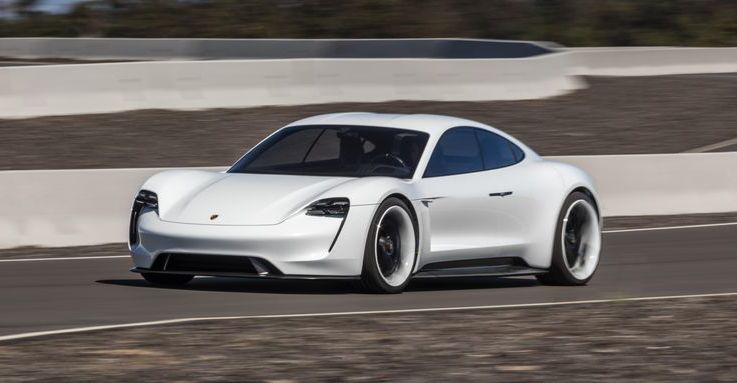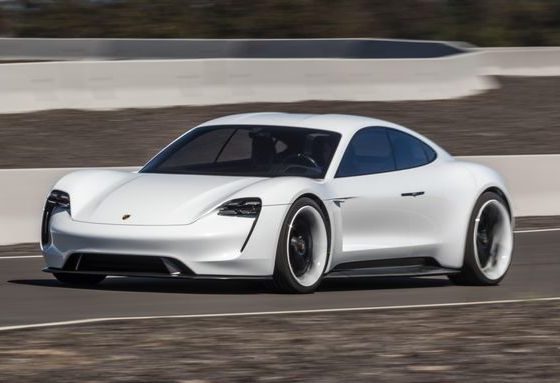

News
Tesla’s vehicle performance downplayed by Porsche Mission E exec
Porsche’s Vice President of Product Line BEV, Stefan Weckbach, recently threw some shade at Tesla, stating that the Mission E, the German automaker’s upcoming rival to the Model S, will not have the limitations present in its iconic American counterpart.
The Porsche executive underplayed the performance of the Tesla’s flagship Model S, stating that the vehicle’s capabilities carry a significant weakness since the car is unable to maintain optimum levels of performance for extended periods of time. According to Weckbach, this particular weakness will not be present in the Mission E.
“(Tesla’s) system is throttled. Porsche drivers won’t need to worry about that because the Mission E’s being developed to deliver reproducible performance and a top speed which can be maintained for long periods,” the Porsche exec said according to Autoblog. Weckback asserted that Tesla’s ubiquitous and world record-setting 0-60 mph prowess will fail after a couple of runs. “But only twice — the third attempt will fail.” said the Mission E lead.
While Weckbach’s comments might have been somewhat accurate back when Tesla was limiting the use of its Ludicrous Mode to prevent the expedited wear and tear on its vehicles’ drivetrain and motor, the Porsche exec’s statements are not very accurate in the present context of Tesla’s vehicles. Both the Model S and the Model X, after all, are now capable of launching with Ludicrous Mode consistently, though the electric cars are still yet to dominate in an area where Porsche has expertise — extended performance driving on a track.
Weckbach further asserted that the Mission E would be absent of any gimmicks, dismissing the idea of simulating internal combustion engine sounds on the electric car to give it more character, even stating that the legacy automaker would not “lower” itself with such features. Weckbach asserted, however, that the Mission E will still provide its drivers with an ‘emotional’ experience that is comparable to those provided by the company’s iconic vehicles such as the Porsche 911 and the 918 Spyder.
ALSO SEE: Ludicrous Tesla Model S teaches showboating Porsche why electric drivetrains win [Video]
“Porsche is unlikely to lower itself to gimmicks of this kind or use sound effects. Any sound the Mission E makes will work to enhance the emotional factor of the car, and incorporate a clear reference to the technology,” Weckbach said.
Apart from his comments about Tesla and the lack of gimmicks on the Mission E, the Porsche exec also provided some tidbits of information about the upcoming electric car’s gear and luggage space.
“The front of the Mission E will contain lots of high-tech gear — the electric motor, the power electronics, the cooling system and other high-voltage components. Even with that, there are still 100 liters of space for luggage,” the exec said.
As we noted in a previous report, Porsche is doubling down on its efforts to meet Tesla head-on, investing $7.4 billion on its green car initiatives. Apart from the development of its electric and hybrid cars, Porsche is also investing $868 million in the construction of an ultra-fast charging network for its vehicles. Dubbed the Ionity network, Porsche response to Tesla’s Superchargers is reportedly designed to provide a standard output of 350 kW, which would enable owners of the Mission E to get 248 miles of charge in just 15 minutes. In comparison, Tesla’s Superchargers have a standard output of about 120 kW.

Elon Musk
Starlink passes 9 million active customers just weeks after hitting 8 million
The milestone highlights the accelerating growth of Starlink, which has now been adding over 20,000 new users per day.

SpaceX’s Starlink satellite internet service has continued its rapid global expansion, surpassing 9 million active customers just weeks after crossing the 8 million mark.
The milestone highlights the accelerating growth of Starlink, which has now been adding over 20,000 new users per day.
9 million customers
In a post on X, SpaceX stated that Starlink now serves over 9 million active users across 155 countries, territories, and markets. The company reached 8 million customers in early November, meaning it added roughly 1 million subscribers in under seven weeks, or about 21,275 new users on average per day.
“Starlink is connecting more than 9M active customers with high-speed internet across 155 countries, territories, and many other markets,” Starlink wrote in a post on its official X account. SpaceX President Gwynne Shotwell also celebrated the milestone on X. “A huge thank you to all of our customers and congrats to the Starlink team for such an incredible product,” she wrote.
That growth rate reflects both rising demand for broadband in underserved regions and Starlink’s expanding satellite constellation, which now includes more than 9,000 low-Earth-orbit satellites designed to deliver high-speed, low-latency internet worldwide.
Starlink’s momentum
Starlink’s momentum has been building up. SpaceX reported 4.6 million Starlink customers in December 2024, followed by 7 million by August 2025, and 8 million customers in November. Independent data also suggests Starlink usage is rising sharply, with Cloudflare reporting that global web traffic from Starlink users more than doubled in 2025, as noted in an Insider report.
Starlink’s momentum is increasingly tied to SpaceX’s broader financial outlook. Elon Musk has said the satellite network is “by far” the company’s largest revenue driver, and reports suggest SpaceX may be positioning itself for an initial public offering as soon as next year, with valuations estimated as high as $1.5 trillion. Musk has also suggested in the past that Starlink could have its own IPO in the future.
News
NVIDIA Director of Robotics: Tesla FSD v14 is the first AI to pass the “Physical Turing Test”
After testing FSD v14, Fan stated that his experience with FSD felt magical at first, but it soon started to feel like a routine.

NVIDIA Director of Robotics Jim Fan has praised Tesla’s Full Self-Driving (Supervised) v14 as the first AI to pass what he described as a “Physical Turing Test.”
After testing FSD v14, Fan stated that his experience with FSD felt magical at first, but it soon started to feel like a routine. And just like smartphones today, removing it now would “actively hurt.”
Jim Fan’s hands-on FSD v14 impressions
Fan, a leading researcher in embodied AI who is currently solving Physical AI at NVIDIA and spearheading the company’s Project GR00T initiative, noted that he actually was late to the Tesla game. He was, however, one of the first to try out FSD v14.
“I was very late to own a Tesla but among the earliest to try out FSD v14. It’s perhaps the first time I experience an AI that passes the Physical Turing Test: after a long day at work, you press a button, lay back, and couldn’t tell if a neural net or a human drove you home,” Fan wrote in a post on X.
Fan added: “Despite knowing exactly how robot learning works, I still find it magical watching the steering wheel turn by itself. First it feels surreal, next it becomes routine. Then, like the smartphone, taking it away actively hurts. This is how humanity gets rewired and glued to god-like technologies.”
The Physical Turing Test
The original Turing Test was conceived by Alan Turing in 1950, and it was aimed at determining if a machine could exhibit behavior that is equivalent to or indistinguishable from a human. By focusing on text-based conversations, the original Turing Test set a high bar for natural language processing and machine learning.
This test has been passed by today’s large language models. However, the capability to converse in a humanlike manner is a completely different challenge from performing real-world problem-solving or physical interactions. Thus, Fan introduced the Physical Turing Test, which challenges AI systems to demonstrate intelligence through physical actions.
Based on Fan’s comments, Tesla has demonstrated these intelligent physical actions with FSD v14. Elon Musk agreed with the NVIDIA executive, stating in a post on X that with FSD v14, “you can sense the sentience maturing.” Musk also praised Tesla AI, calling it the best “real-world AI” today.
News
Tesla AI team burns the Christmas midnight oil by releasing FSD v14.2.2.1
The update was released just a day after FSD v14.2.2 started rolling out to customers.

Tesla is burning the midnight oil this Christmas, with the Tesla AI team quietly rolling out Full Self-Driving (Supervised) v14.2.2.1 just a day after FSD v14.2.2 started rolling out to customers.
Tesla owner shares insights on FSD v14.2.2.1
Longtime Tesla owner and FSD tester @BLKMDL3 shared some insights following several drives with FSD v14.2.2.1 in rainy Los Angeles conditions with standing water and faded lane lines. He reported zero steering hesitation or stutter, confident lane changes, and maneuvers executed with precision that evoked the performance of Tesla’s driverless Robotaxis in Austin.
Parking performance impressed, with most spots nailed perfectly, including tight, sharp turns, in single attempts without shaky steering. One minor offset happened only due to another vehicle that was parked over the line, which FSD accommodated by a few extra inches. In rain that typically erases road markings, FSD visualized lanes and turn lines better than humans, positioning itself flawlessly when entering new streets as well.
“Took it up a dark, wet, and twisty canyon road up and down the hill tonight and it went very well as to be expected. Stayed centered in the lane, kept speed well and gives a confidence inspiring steering feel where it handles these curvy roads better than the majority of human drivers,” the Tesla owner wrote in a post on X.
Tesla’s FSD v14.2.2 update
Just a day before FSD v14.2.2.1’s release, Tesla rolled out FSD v14.2.2, which was focused on smoother real-world performance, better obstacle awareness, and precise end-of-trip routing. According to the update’s release notes, FSD v14.2.2 upgrades the vision encoder neural network with higher resolution features, enhancing detection of emergency vehicles, road obstacles, and human gestures.
New Arrival Options also allowed users to select preferred drop-off styles, such as Parking Lot, Street, Driveway, Parking Garage, or Curbside, with the navigation pin automatically adjusting to the ideal spot. Other refinements include pulling over for emergency vehicles, real-time vision-based detours for blocked roads, improved gate and debris handling, and Speed Profiles for customized driving styles.








